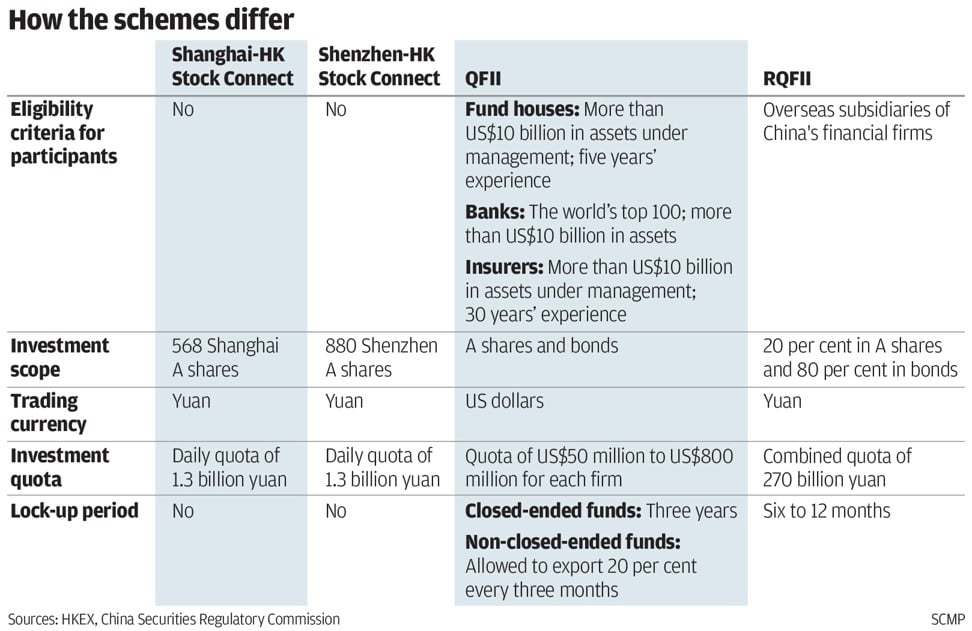
China scraps QFII and RQFII investments quota to allow unrestricted access to world’s second-largest capital market
- China’s currency regulator has announced that it would scrap the investment quotas under the QFII and RQFII programmes
- The Qualified Foreign Institutional Investor (QFII) programme, introduced in 2002, lets investors buy China’s yuan-denominated A shares. The RQFII programme, introduced in 2011, is denominated in yuan
China scrapped two equity investment limits for foreigners, giving global traders unfettered access to the world’s second-largest capital market in another move in the country’s economic liberalisation.
The removal of the first quota, after 17 years of a gradual, regulated opening of China’s equities, removes one of the major vestiges of the country’s closed capital markets. It is also a nod to the ongoing negotiations to resolve the year-long US-China trade war, which has sought to remove restrictions on foreign investments, address American concerns of China’s track record on intellectual property, among other trade issues.
“The move is an important measure that China has taken to further open up the financial markets,” said Min Liangchao, a strategist at HSBC Jintrust Fund Management in Shanghai. “In the long run, it will attract more overseas funds to the A-share market. It’s a positive move, either in terms of increasing liquidity or further establishing the value investing concept.”
As many as 292 overseas foreign investors, including fund management firms and sovereign funds, were approved to invest a combined US$111.4 billion in Chinese stocks and bonds as at the end of August, according to the foreign exchange regulator. The RQFII approved quotas amounted to 693.3 billion yuan, the data showed.
China now still imposes restrictions on domestic individuals investing in securities overseas. They need to go through the Qualified Domestic Institutional Investor (QDII) scheme, in which banks and asset management firms invest on behalf of individual investors after getting quotas from the government.
To some extent, the two programmes had become redundant ever since a cross-border investment channel known as the Stock Connect was established in 2014 to allow mainland investors transact in Hong Kong-traded stocks, and for foreign investors to buy and sell equities in Shanghai and Shenzhen.
Unlike the QFII and RQFII systems, investors using the Connect link can buy stocks without requiring licenses granted by the currency or securities regulators.
The first Connect programme between the Shanghai and Hong Kong bourses in November 2014 quickly expanded to include the Shenzhen exchange, and now the London exchange. Similar channels have been established for bonds, and even commodities.
Foreign investors have been playing an increasingly prominent role in China’s stocks market. They held a combined 1.68 trillion yuan of Chinese stocks as of the first quarter, closing in on the total stock holdings of China’s mutual funds.
They have been buying Chinese consumer stocks from liquor distiller Kweichow Moutai and duty-free shop operator China International Travel Service, sending their stock prices to records this year. Another stock, Han’s Laset Technology, was so well sought after by offshore investors that trading in its shares had to be halted in May because the limit on foreign ownership was reached.
The quota removal may also ease the frayed trade relation between China and the United States, as the two nations return to the negotiating table next month to resolve their year-long trade war. The Trump administration had pushed China to remove barriers to global capital, including the removal of ownership limits on banks, and better access to the country’s wealth management and investment products.
In response, the Chinese government has deregulated the capital and banking markets to give foreign investors greater access. In April 2018, Beijing lifted a limit, giving foreign brokers majority control of their mainland ventures. Last month, the asset management unit of JPMorgan Chase & Co. became the first foreign institution to take control of a Chinese asset management firm.
“China has reasons to further open up its markets to global investors and companies because foreign funds and foreign trade are undoubtedly instrumental in buoying the country’s economic growth,” said Professor Quan Heng, a research fellow at Fudan University’s Research Institute of China Economy. “It is advisable for the central government to drastically conduct liberalisations sooner rather than later.”



